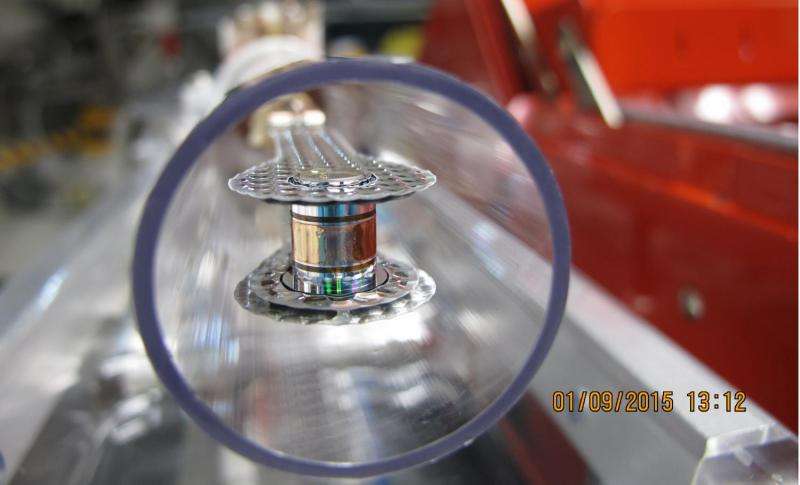This target was used in a three-shock adiabat-shaping experiment.
In a recent series of papers, Lawrence Livermore National Laboratory (LLNL) scientists examined the role of ablation-front instability and capsule convergence ratio in ignition science experiments at the National Ignition Facility (NIF).
The papers address different aspects of an "adiabat-shaping" experimental campaign, which was performed to controllably assess the effects of ablation-front instability growth vs. fuel adiabat (compression) on implosion performance.
The researchers said this work marks an important step forward in the quest for ignition by demonstrating that ablation front growth can be managed while simultaneously achieving high areal density, a necessary requirement for inertial confinement fusion (ICF) ignition. Furthermore, the results help to implicate ablation-front growth as one of the dominant sources of performance degradation during the National Ignition Campaign (NIC). After addressing these issues, the adiabat-shaped low-foot platform may provide a path to improved performance at high areal density.
The campaign was designed to understand the physics of layered deuterium-tritium (DT) implosions as related to the four-shock low-foot (LF) approach used during the National Ignition Campaign that featured a lower foot, or initial laser picket, in the laser pulse, and the three-shock high-foot (HF) approach that featured a higher foot in the laser pulse.
Two new drives were designed for this mini-campaign: a four-shock adiabat-shaped drive derived from the LF drive and a three-shock adiabat-shaped drive derived from the HF drive. Adiabat shaping is based on a strong first shock that decays as it propagates through the shell of the target capsule toward the DT fuel. It sets the ablation front at a higher adiabat (beneficial for stabilization of hydrodynamic instabilities) while keeping the adiabat in the DT fuel at a lower adiabat (needed for high compression). The concept of adiabat shaping was previously proposed and developed in direct-drive ICF experiments (NIF experiments are primarily indirect drive).
In a Physical Review Letters paper titled "Improved performance of high areal density indirect drive implosions at the National Ignition Facility using a four-shock adiabat shaped drive (link is external)," lead author Dan Casey and colleagues describe a significant improvement in implosion performance using a four-shock adiabat-shaped drive with a small increase in early-time laser pulse energy. This modest laser pulse change (a less than 1 percent change in total energy) leads to reduced ablation front instability growth while simultaneously allowing for a low fuel adiabat, resulting in high implosion areal density.
"This adiabat-shaped version of the LF showed a three to 10 times improvement in yield compared to similar experiments during the National Ignition Campaign," Casey said. "This result helps to separate the deleterious impact of ablation front growth from convergence on implosions during the NIC and supports the hypothesis that seeds at the ablation front—for example, the capsule support tent— played a significant role in limiting (implosion) performance."
In a Physics of Plasmas paper titled "Stabilization of high-compression, indirect-drive inertial confinement fusion implosions using a 4-shock adiabat-shaped drive (link is external)," lead author Andrew MacPhee and colleagues describe using the recently developed laser pulse profile to address the hydrodynamic instabilities and poor fuel compression that have been major factors in capsule performance degradation. This approach allowed the researchers to manage the instabilities, thus reducing ablation front growth compared to the standard ignition pulse as directly demonstrated by these experiments, while maintaining conditions for a low fuel adiabat needed for increased compression.
Finally, in another Physics of Plasmas paper titled, "First results of radiation driven, layered deuterium-tritium implosions with a 3-shock adiabat-shaped drive at the National Ignition Facility, (link is external)" lead author Vladimir Smalyuk and colleagues discuss using the campaign's new three-shock adiabat-shaped drive, derived from the HF pulse, to increase the overall capsule convergence ratio and compression.
"The fuel areal density was improved by approximately 25 percent with this new drive compared to similar high-foot implosions," Smalyuk said. "Neutron yield was improved by more than four times compared to low-foot implosions driven at the same compression and implosion velocity."
More information: D. T. Casey et al. Improved Performance of High Areal Density Indirect Drive Implosions at the National Ignition Facility using a Four-Shock Adiabat Shaped Drive, Physical Review Letters (2015). DOI: 10.1103/PhysRevLett.115.105001
A. G. MacPhee et al. Stabilization of high-compression, indirect-drive inertial confinement fusion implosions using a 4-shock adiabat-shaped drive, Physics of Plasmas (2015). DOI: 10.1063/1.4928909
V. A. Smalyuk et al. First results of radiation-driven, layered deuterium-tritium implosions with a 3-shock adiabat-shaped drive at the National Ignition Facility, Physics of Plasmas (2015). DOI: 10.1063/1.4929912
Journal information: Physical Review Letters , Physics of Plasmas
Provided by Lawrence Livermore National Laboratory
























